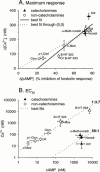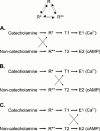Agonist trafficking of G(i/o)-mediated alpha(2A)-adrenoceptor responses in HEL 92.1.7 cells
- PMID: 11264241
- PMCID: PMC1572699
- DOI: 10.1038/sj.bjp.0703964
Agonist trafficking of G(i/o)-mediated alpha(2A)-adrenoceptor responses in HEL 92.1.7 cells
Abstract
1. The ability of 19 agonists to elevate Ca(2+) and inhibit forskolin-induced cyclic AMP elevation through alpha(2A)-adrenoceptors in HEL 92.1.7 cells was investigated. Ligands of catecholamine-like- (five), imidazoline- (nine) and non-catecholamine-non-imidazoline-type (five) were included. 2. The relative maximum responses were similar in both assays. Five ligands were full or nearly full agonists, six produced 20 - 70% of the response to a full agonist and the remaining eight gave lower responses (< 20%) so that their potencies were difficult to evaluate. 3. Marked differences in the potencies of the agonists with respect to the two measured responses were seen. The catecholamines were several times less potent in decreasing cyclic AMP than in increasing Ca(2+), whereas the other, both imidazoline and ox-/thiazoloazepine ligands, were several times more potent with respect to the former than the latter response. For instance, UK14,304 was more potent than adrenaline with respect to the cyclic AMP response but less potent than adrenaline with respect to the Ca(2+) response. 4. All the responses were sensitive to pertussis toxin-pretreatment. Also the possible role of PLA(2), beta-adrenoceptors or ligand transport or metabolism as a source of error could be excluded. The results suggest that the active receptor states produced by catecholamines and the other agonists are markedly different and therefore have different abilities to activate different signalling pathways.
Figures



Similar articles
-
Partial to complete antagonism by putative antagonists at the wild-type alpha(2C)-adrenoceptor based on kinetic analyses of agonist:antagonist interactions.Br J Pharmacol. 2000 Dec;131(7):1385-90. doi: 10.1038/sj.bjp.0703726. Br J Pharmacol. 2000. PMID: 11090111 Free PMC article.
-
Alpha 2A-adrenoceptors mediate activation of non-selective cation channels via Gi-proteins in human erythroleukaemia (HEL) cells. No evidence for a functional role of imidazoline receptors in modulating calcium.Biochem Pharmacol. 1995 Jan 18;49(2):187-96. doi: 10.1016/s0006-2952(94)00432-3. Biochem Pharmacol. 1995. PMID: 7530955
-
Facilitation of constitutive alpha(2A)-adrenoceptor activity by both single amino acid mutation (Thr(373)Lys) and g(alphao) protein coexpression: evidence for inverse agonism.J Pharmacol Exp Ther. 2000 Feb;292(2):654-63. J Pharmacol Exp Ther. 2000. PMID: 10640303
-
Clinical Use of Adrenergic Receptor Ligands in Acute Care Settings.Handb Exp Pharmacol. 2024;285:617-637. doi: 10.1007/164_2023_705. Handb Exp Pharmacol. 2024. PMID: 38177400 Review.
-
Localization and trafficking of alpha2-adrenergic receptor subtypes in cells and tissues.Pharmacol Ther. 1999 Nov;84(2):193-205. doi: 10.1016/s0163-7258(99)00032-7. Pharmacol Ther. 1999. PMID: 10596906 Review.
Cited by
-
Biased signaling in naturally occurring mutations of G protein-coupled receptors associated with diverse human diseases.Biochim Biophys Acta Mol Basis Dis. 2021 Jan 1;1867(1):165973. doi: 10.1016/j.bbadis.2020.165973. Epub 2020 Sep 17. Biochim Biophys Acta Mol Basis Dis. 2021. PMID: 32949766 Free PMC article. Review.
-
Functional signaling biases in G protein-coupled receptors: Game Theory and receptor dynamics.Mini Rev Med Chem. 2012 Aug;12(9):831-40. doi: 10.2174/138955712800959071. Mini Rev Med Chem. 2012. PMID: 22681251 Free PMC article. Review.
-
Seven transmembrane receptors as shapeshifting proteins: the impact of allosteric modulation and functional selectivity on new drug discovery.Pharmacol Rev. 2010 Jun;62(2):265-304. doi: 10.1124/pr.108.000992. Epub 2010 Apr 14. Pharmacol Rev. 2010. PMID: 20392808 Free PMC article. Review.
-
Coupling of the human A1 adenosine receptor to different heterotrimeric G proteins: evidence for agonist-specific G protein activation.Br J Pharmacol. 2004 Nov;143(6):705-14. doi: 10.1038/sj.bjp.0705925. Epub 2004 Aug 9. Br J Pharmacol. 2004. PMID: 15302686 Free PMC article.
-
Arachidonic acid release mediated by OX1 orexin receptors.Br J Pharmacol. 2010 Jan;159(1):212-21. doi: 10.1111/j.1476-5381.2009.00535.x. Epub 2009 Dec 4. Br J Pharmacol. 2010. PMID: 20002100 Free PMC article.
References
-
- ABURTO T.K., LAJOIE C., MORGAN K.G. Mechanisms of signal transduction during alpha 2-adrenergic receptor-mediated contraction of vascular smooth muscle. Circ. Res. 1993;72:778–785. - PubMed
-
- ÅKERMAN K.E.O., NÄSMAN J., LUND P.E., SHARIATMADARI R., KUKKONEN J.P. Endogenous extracellular purine nucleotides redirect alpha2-adrenoceptor signaling. FEBS Lett. 1998;430:209–212. - PubMed
-
- BERG K.A., MAAYANI S., GOLDFARB J., SCARMELLINI C., LEFF P., CLARKE W.P. Effector pathway-dependent relative efficacy at serotonin type 2A and 2C receptors: evidence for agonist-directed trafficking of receptor stimulus. Mol. Pharmacol. 1998;54:94–104. - PubMed
-
- BODDEKE H.W. Different effects of muscarinic agonists in rat superior cervical ganglion and hippocampal slices. Eur. J. Pharmacol. 1991;201:191–197. - PubMed
Publication types
MeSH terms
Substances
LinkOut - more resources
Full Text Sources
Miscellaneous

